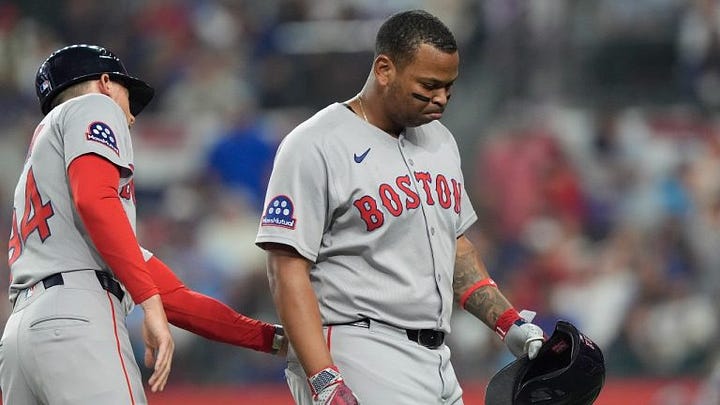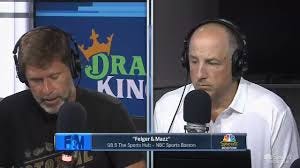Boston’s Rafael Devers began the 2025 season with a major-league record 15 strikeouts in the team’s first five games. And he’s one of the game’s best hitters. Though Devers has straightened out some — he’s gotten a few hits lately — his troubles are just emblematic of larger, more serious problems in what we used to call “The Grand Ole Game.”
Baseball’s problem, simply stated, is velocity. Everybody has it. The old theories of using an assortment of pitches of varied speeds to confuse or befuddle a hitter has been supplanted with a much more basic equation — Throw the damn ball BY him. Period.
It’s easier on the defense, which instead of having to record 27 outs with their assorted gloves now can often count on roughly half of those outs coming in a single glove — the catcher’s. Because velocity has increased so dramatically over the past few seasons, batters have found just making contact — actually hitting the baseball — increasingly impossible. The old ideas of bunting, hitting behind the runner, hit-and-run are pretty much outdated because few players now can execute them.


As I mentioned in previous posts, my son John, playing in the American Association last season, had just 30 strikeouts (some called) and 71 walks in a 100-game schedule and he was one of, at last count, only three players in the ranks of professional baseball who had more walks than strikeouts. Strikeouts, once shamefully memorialized in the famous “Casey At The Bat” poem, are no longer seen that way. A modern re-write might be “How Casey’s errant bat angle led to a lack of hitting surface connection.” Not much poetry in that.
The Red Sox are one of a number of major-league teams teaching the “Driveline” approach to hitting: essentially, where every swing is aimed exclusively at hitting the ball in the air to the general exclusion of aiming for line drives or even hard ground balls. This approach, combined with the Red Sox’ recent tendency to leave large numbers of runners on base — an issue that also plagued the Florida State Seminoles the other night vs. Florida — just set Boston sports talk wizards (Mike) Felger and (Tony) Mazz on the warpath this afternoon.
As a lifelong Boston Red Sox fan exiled here in Florida for the past 32 years, my main connection with Boston are the Boston Globe and these afternoon sports talk shows, most notably Felger and Mazz afternoon drive time, the top broadcast in the Hub. They were on such a rant today about the Red Sox’ struggles in the series with the Toronto Blue Jays, a 2-1 extra-inning loss Tuesday night, their 14 strikeouts and mostly, the team’s not only inability but an utter unwillingness to advance runners, drove these two broadcasters nuts, raging on and on about the Red Sox’s “Driveline” approach to hitting.
There recently was a much publicized incident in Boston where a young player happened to ask Red Sox Hall of Famer Jim Rice for hitting advice. And when Rice offered it to the player, a member of the coaching staff stepped in and said that they weren’t teaching that philosophy any longer. Oh.
Whether it’s “Driveline” or some other hitting theory, baseball pitching coaches opening the Pandora’s Box of velocity has turned most at bats into an either-or proposition, with good solid bat-to-ball contact increasingly rare. And it’s not as if there is any immediate remedy to stop the velocity from increasing.
Leagues have tried moving the mound back from 60 feet, 6 inches but that didn’t work. There was a mini-sensation about the “torpedo” bats at the start of the season but that quickly died down. Because the velocity is so difficult to match and an arm that can whistle a baseball that fast can generally make the ball do other unhittable things, the idea of someone maintaining a .300 average over a season of 162 games; someone who fails seven of 10 times yet is celebrated because of how difficult that truly is, we may see fewer and fewer of these guys as we move forward.
It has become a power game — on the mound and at the plate and frankly, that’s just not as interesting a sport to watch as it once was. In writing “Diamond Duels,” my new baseball book, I knew all the names, remembered their strengths and weaknesses and delighted in finding out the specifics — how Hank Aaron started 1-for-23 against Don Drysdale, yet wound up reaching him for 17 home runs. Or how a pitcher who once went 4-and-25 held the great Rogers Hornsby (.358 lifetime) to a .130 average. These delightful peculiarities, these details that helped make the sport the fascinating game it can be, I fear are being data-driven out of the game.
There are other inherent problems. Two teams, Tampa and Sacramento, aren’t playing where they’re supposed to. ESPN has dropped MLB after this season, sending the sport to find other ways to offer it to viewers, which is why you’re seeing the streaming offers offers all over the TV.
Former Giant Bill Terry, a .400 hitter, once quipped “Baseball must be a great game to survive the fools who run it." Let’s hope the game can keep on surviving. But I must admit, I’m worried.




The computer nerds have taken over baseball... oh don't listen to Hall of Famer Jim Rice, listen to the idiot nerd who has never swung a bat! Red Sox lead all of the MLB in strikeouts and runners left on base. So many times in these 14 first games they could of made a difference just by moving the runners (just making contact), but nooooo (in my best John Belushi voice),
everyone is playing "hero ball" and trying to knock it out of the park. The pitching game is also screwed up by the nerds as well! Red Sox pitching coach Andrew Bailey's Irish Cream, has them throwing mostly sweepers... have you noticed there are more "Tommy John" and torned rotator cuffs surgeries than every, yet these guys can't pitch more than 5 or 6 innings. It's a disgrace what they have done to baseball... don't even get me started with the NFL.
The rise of analytics has certainly shown the value of the home run, but it didn't make pitchers reach 100 mph consistently. That's the real problem.
If moving the mound back doesn't do it, then we need to find another way.